Nicholson II (Destroyer No. 52)
1915-1936
Samuel Nicholson -- born in Chestertown, Md., in 1743 -- was the second son of Joseph and Hannah Scott Nicholson. Joining the Continental Navy, he was appointed a captain on 10 December 1776. He was subsequently appointed to command of the French-built frigate Deane, which sailed from Boston on 14 January 1779 in company with the frigate Alliance for a cruise in the West Indies. Deane returned to Philadelphia on 17 April with one prize, the armed ship Viper. On 29 July, she joined with the frigate Boston and two ships of the Virginia Navy guarding a convoy of merchantmen out to sea and continuing on for a five-week cruise which netted eight prizes, including four privateers, the packet Sandwich, and the sloop-of-war HMS Thorn. The frigates arrived at Boston on 6 September with 250 prisoners after one of the most notable cruises of the Continental Navy.
During the winter and early spring of 1781 and again in 1782, Deane cruised with the frigates Confederacy and Saratoga in the West Indies, capturing four prizes on the second of these ventures. After two more cruises in the Caribbean, one in September 1782, during which the ship was renamed Hague and the other in 1783. She was placed out of commission at Boston in 1783. Again appointed to the rank of Captain upon the reorganization of the Navy in 1794, he supervised the construction of the frigate Constitution at Edmund Hartt's shipyard in Boston. With her commissioning, Nicholson served as her first commanding officer. He died at Charlestown, Mass., on 29 December 1811.
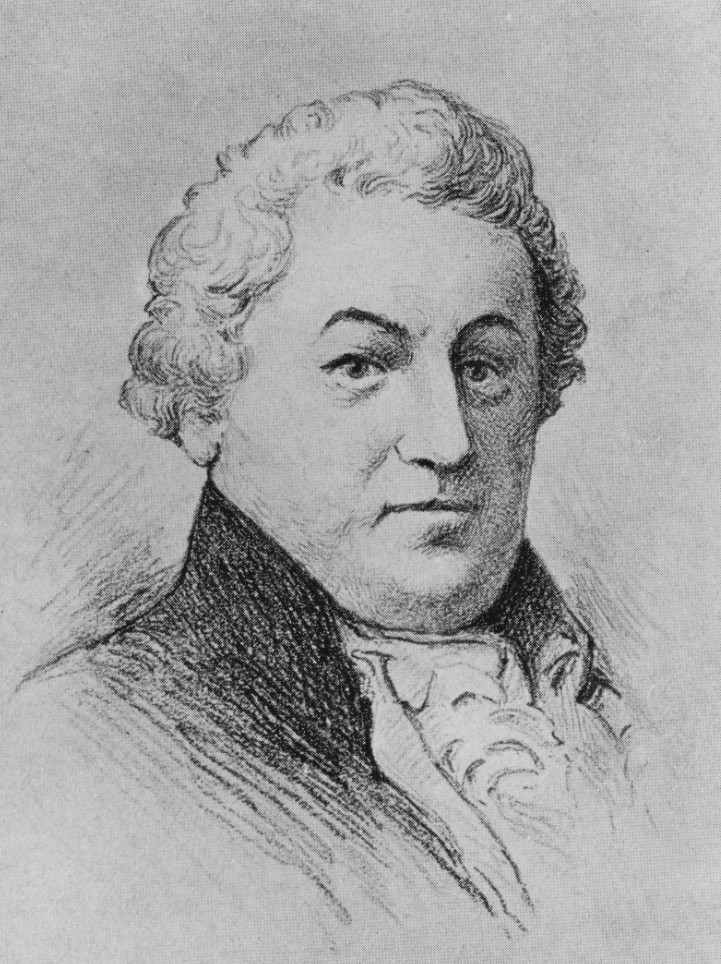
II
(Destroyer No. 52: displacement 1,050; length 305'3"; beam 29'10"; draft 9'3"; speed 29 knots; complement 112; armament 4 4-inch/50 caliber, 1 3-inch, 4 21-inch torpedo tubes; class O'Brien)
The second Nicholson (Destroyer No. 52) was laid down on 8 September 1913, at Philadelphia, by William Cramp & Sons Shipyard; launched on 19 August 1914; sponsored by Mrs. Sophie Davis Taylor, wife of the Treasurer of William Cramp & Sons and grand-daughter of William Cramp, the company’s founder; and commissioned on 30 April 1915, Lt. Cmdr. Adolphus E. Watson in command.
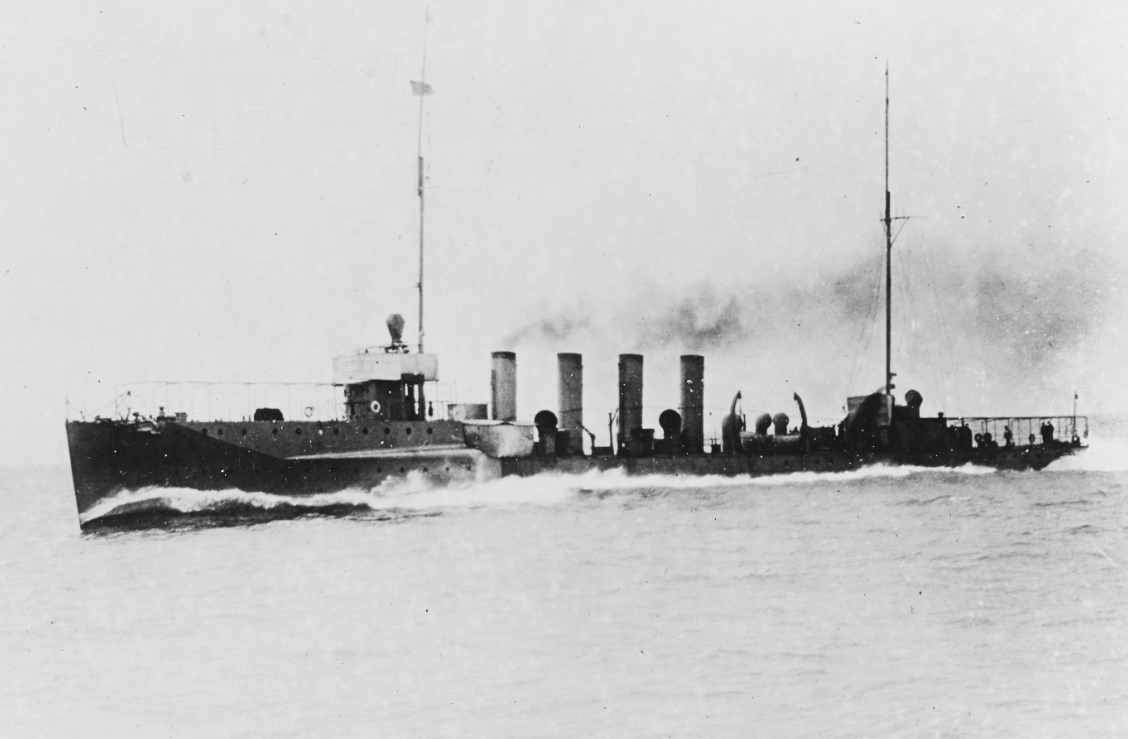
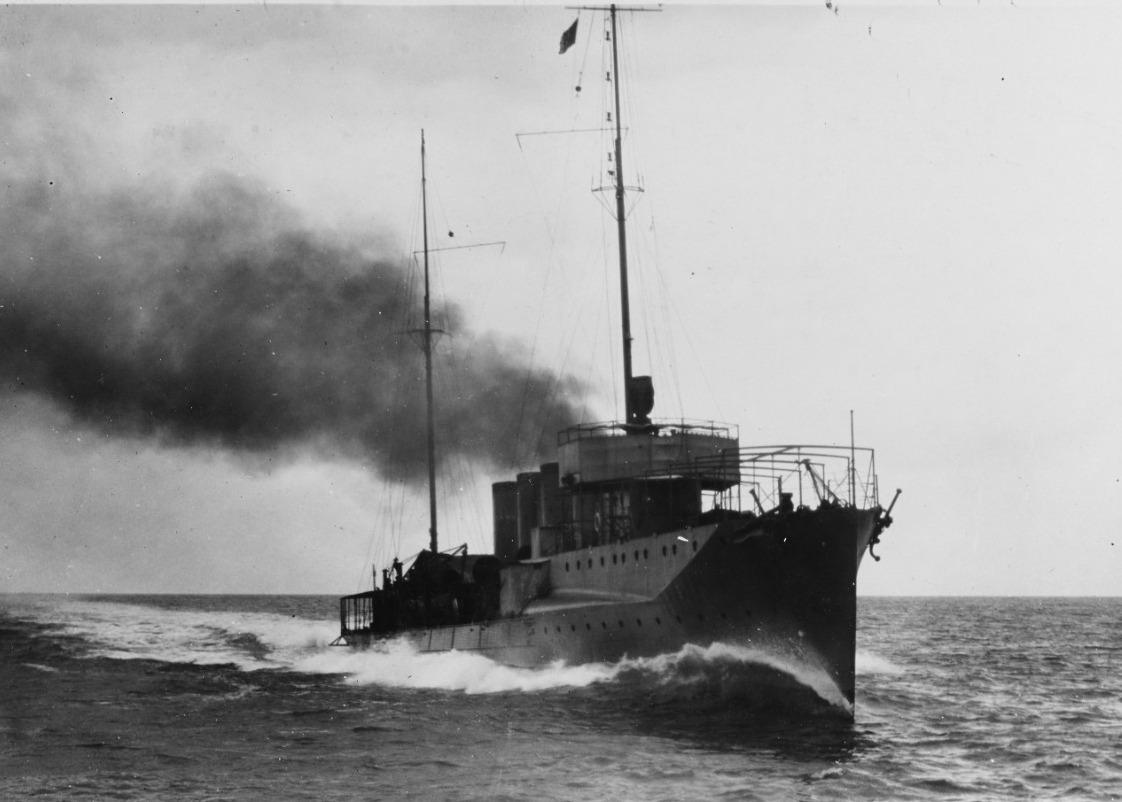
After her commissioning, Nicholson conducted her trial runs off the North Atlantic coast operating between Newport, R.I. and Boston, Mass., (15 July-23 August 1915). Departing Newport on 23 August, she went to sea and steamed to Hampton Roads, Va., whence she moved into Chesapeake Bay on 5 September. She then returned to the Philadelphia Navy Yard on 11 September, and then shifted into the Cramp yard on the 13th, for post-trial maintenance and modifications. Nicholson remained there until 2 October, when she cleared the builder’s yard and steamed to Newport. Arriving the next day, she remained overnight and then got underway for maneuvers on 4 October. Returning to Newport on 9 October, she remained there until 25 October, when she got underway for Stratford Shoal in Long Island Sound.
Returning the next day, 26 October 1915, she remained in port until 1 November, when she got underway for Rosebank [Staten Island], N.Y. Reaching that same day; she remained there until departing on the 9th. She touched at Newport on 10 November en route to Boston, where she arrived later that day. Nicholson remained at Boston through the end of the year. During this time, she received orders transferring her from the Extra Division to the Seventh Division, Torpedo Flotilla, Atlantic Fleet on 13 December 1915.
Nicholson got underway again and departed Boston on 3 January 1916. Bound for the New York Navy Yard, Brooklyn, N.Y., she arrived on 4 January, and entered the yard. Remaining until 6 January, she departed for annual winter fleet maneuvers in the Caribbean Sea and arrived at Culebra Island on 16 January. She operated in the waters around Cuba and Puerto Rico conducting target practices, tactical exercises, and port visits through the winter at San Juan, Puerto Rico (19-20 January); Guantanamo Bay, Cuba (21-26 January and 9-10 April); Guacanayabo Bay (27 January-3 March); and Cienfuegos, Cuba (4-9 March). Departing Guantanamo Bay, on 10 April, she stood in to the Philadelphia Navy Yard on 12 April and then entered the Cramp Yard. She remained there until 14 April, when she exited and shifted to Fort Mifflin, Pa. Remaining until 28 April, she departed bound for Virginia and entering the Norfolk (Va.) Navy Yard on 1 May. Clearing on 21 May, she steamed north to Gardiners Bay, N.Y. Reaching on the 22nd; she remained overnight and then moved on to Newport, the next day. Getting underway on the 30th, Nicholson steamed to New York, and entered the New York Navy Yard on 31 May, for repairs to her turbines. She undocked on 31 August, and cleared the yard for a day of steaming trials. Returning that same day, she underwent additional refit and repairs.
Nicholson departed the New York Navy Yard on 13 September 1916. Bound for the Virginia capes, she entered Chesapeake Bay and moored at Hampton Roads on 14 September. The next day, she went to sea to conduct exercises on the Southern Drill Grounds and returned to Hampton Roads on 16 September. The destroyer continued to conduct training and trials in the Virginia capes area from 16-27 September. Departing Norfolk on 28 September, she steamed to Newport, arriving the next day. Over the next month, she conducted training in the waters off Rhode Island based on Newport. Departing on 29 October, she steamed to the New York Navy Yard. Arriving that same day, she remained until 10 December. Clearing New York that day, she steamed southward to Hampton Roads (11-12 December), then back north to Provincetown, Mass. (16-18 December), then returned to New York, arriving at Whitestone, N.Y., later on the 18th. The next day, she shifted to the New York Navy Yard, where she remained into the New Year.
Nicholson resumed operations underway on 10 January 1917, when she went to sea bound for the Atlantic Fleet’s annual winter exercises in Caribbean waters. She arrived at Culebra on 14 January, and remained there until 18 January, when she got underway and steamed to Santo Domingo, Dominican Republic, where she arrived on 22 January. Departing that same day, she was bound for Port-au-Prince, Haiti, where she arrived on 25 January. The next day she cleared the port and steamed to Guantanamo Bay, reaching there on the 27th. She remained there until 5 February. With the German announcement of the resumption of unrestricted submarine warfare and the subsequent increased tensions between the U.S. and Germany, the Atlantic Fleet concentrated in the waters of Guacanayabo Bay, Cuba, on 6 February. Nicholson remained there until 21 March, when getting underway, she touched at Santiago de Cuba en route to Guantanamo Bay, arriving the same day. She later returned to Hampton Roads on 27 March and after entering the Norfolk Navy Yard (28-29 March), she shifted to the Atlantic Fleet anchorage in the York River off Yorktown, Va., on 3 April. The declaration of war against Germany on 6 April, saw Nicholson still located at the York River anchorage which was subsequently designated Base No. 2. She returned to the Norfolk Navy Yard (15-17 April) and then back to the anchorage on the 17th. Clearing the fleet anchorage on 27 April, she steamed between the Virginia capes and set a course northward. Entering the New York Navy Yard on 27 April, Nicholson fitted out for distant service.
On 1 May 1917, the Office of the Chief of Naval Operations organized the destroyer forces for overseas deployment by designating Destroyer Division Six as Cushing (Destroyer No. 55) (flagship), Benham (Destroyer No. 49); O’Brien (Destroyer No. 51); Nicholson; Cummings (Destroyer No. 44); and Sampson (Destroyer No. 63) and Destroyer Division Seven as Rowan (Destroyer No. 64 ) (flag); Ericsson (Destroyer No. 56); Winslow (Destroyer No. 53); Jacob Jones (Destroyer No. 61); Cassin (Destroyer No. 43); and Tucker (Destroyer No. 57). Division Seven was ordered to be ready and assembled at Boston, Mass., for sea duty by 5 May, and Division Six was to assemble at New York, for sea duty by 10 May. Nicholson shifted to Tompkinsville [Staten Island], N.Y., on 14 May and the next day, she cleared the Ambrose Channel with Division Six. Steaming westward the division touched at Halifax, Nova Scotia (Base No. 23) on 17 May, and raised Queenstown, Ireland (Base No. 6), on 24 May. Upon their arrival the destroyers reported in to Adm. Sir Lewis Bayly, RN, Commander-in-Chief, Coast of Ireland.
Almost immediately Nicholson began escorting convoys from the Western Approaches into the Irish Sea and conducting anti-submarine patrols off the coast of Ireland. While on patrol Nicholson and Sampson assisted in the recovery of sailors from the sunken British tanker Batoum, that had been torpedoed by U-61 (Kapitänleutnant Victor Dieckmann commanding) on 19 June 1917. Four days later, on 23 June, Cushing, Jacob Jones, Conyngham (Destroyer No. 58), Nicholson, and O’Brien (Destroyer No. 51) out of Queenstown, rendezvoused with Group 1 (of four) of the first American Expeditionary Force (AEF) convoy which sailed from New York on 14 June. The group was now composed of Seattle (Armored Cruiser No. 11), DeKalb (Id. No. 3010), Wilkes (Destroyer No. 67), Terry (Destroyer No. 25), Roe (Destroyer No. 24), U.S. Army Transport (USAT) Tenadores, USAT Saratoga, USAT Havana, and USAT Pastores and proceeded to escort the ships to St. Nazaire, France on 27 June. Leaving that same day, she returned to Queenstown on the 28th. Later, on 13 July, Porter (Destroyer No. 59), Nicholson, Cassin, O’Brien, and Ericsson arrived at St. Nazaire for escort duty. The next day, Seattle, the destroyers Porter, Nicholson, Ericsson, Cassin, O’Brien, the collier Cyclops (Fuel Ship No. 4), the oiler Kanawha (Fuel Ship No. 13) and the transports El Occidente, Edward Luckenbach, Dakotan, Momus, and Montanan sailed from St. Nazaire for New York. The destroyers and oiler Kanawha headed to Queenstown after escorting the convoy to the dispersal point at longitude 17'20°W.
Nicholson was underway on 16 September 1917, after having escorted HMS Cochrane to Devonport, England; she was six miles east of the Scilly Islands, when she rescued 21 sailors off the Norwegian steamer Facto, en route from Le Havre, France, to Cardiff, Wales, which had been torpedoed by UB-18 (Kapitänleutnant Ulrich Meier). Two souls were lost in the sinking. The destroyer returned to Queenstown and landed the survivors there.
A month later, on 18 October 1917, Nicholson was escorting Convoy OQ-14 when Conyngham, the escort flagship, departed the convoy. Assuming leadership of the escort, the destroyer continued with the convoy. The next day, on 19 October, 200 miles west of Brest, U-62 (Kapitänleutnant Ernst Hashagen) shelled J. L. Luckenbach. Responding to the distress signal, Nicholson sped to the scene and steamed into the fray, training her 4-inch guns and firing four shots before U-62 submerged and disappeared. A damage control party from Nicholson under Lt. Hamilton Harlow, Nicholson’s engineering officer, boarded J. L. Luckenbach and helped extinguish the fires in cotton bales that had been ignited by the U-boat’s shellfire. After the fires were controlled, both ships joined convoy HD-7 at 4:25 p.m. Shortly thereafter, at 5:55 p.m., U-62 torpedoed the escort vessel HMS Orama and the convoy was ordered to disperse, despite this, J. L. Luckenbach, with nine wounded, continued her voyage and stood into Le Havre, without further incident.
Nicholson and her sister ship Fanning (Destroyer No. 37) departed from alongside Melville (Destroyer Tender No. 2) at 11:00 a.m. on 17 November 1917, and steamed east out of Queenstown, with the inbound six-ship Convoy OQ-20. On lookout watch aboard Fanning, Coxswain David D. Loomis noticed a periscope which extended about a foot from the top of the waterline off the port bow. The periscope belonged to German submarine U-58 (Kapitänleutnant Gustave Amberger). U-58 fired a torpedo at the British steamer Welshman, and quickly disappeared almost as rapidly as she had been discovered. Fanning maneuvered to where the enemy periscope was sighted and dropped a single depth charge. Cmdr. Frank D. Berrien, commanding officer of Nicholson, also moved into position near Fanning and dropped her own depth charge. At that moment, the conning tower of the elusive submarine appeared on the surface between Nicholson and the convoy, and Nicholson promptly fired three shots from her stern gun. The resulting hits lifted the bow of U-58 up and slammed her back down again, but she righted herself and continued to make speed. Fanning sped after her, cleared Nicholson, and opened fire at the enemy U-boat with her bow gun. After the third shot, and another possible hit on U-58, the crew appeared topside with their arms raised in surrender.
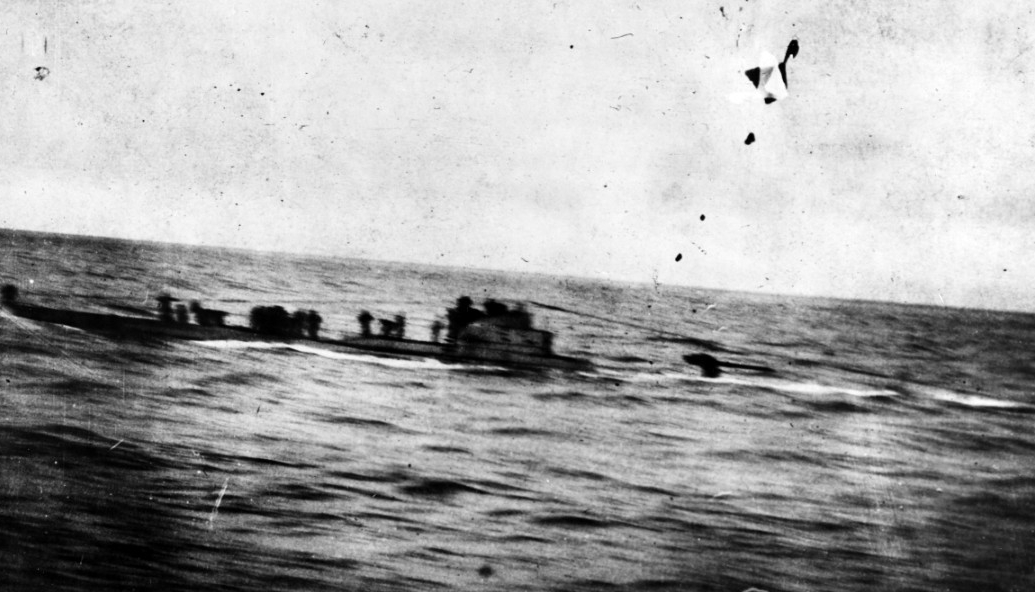
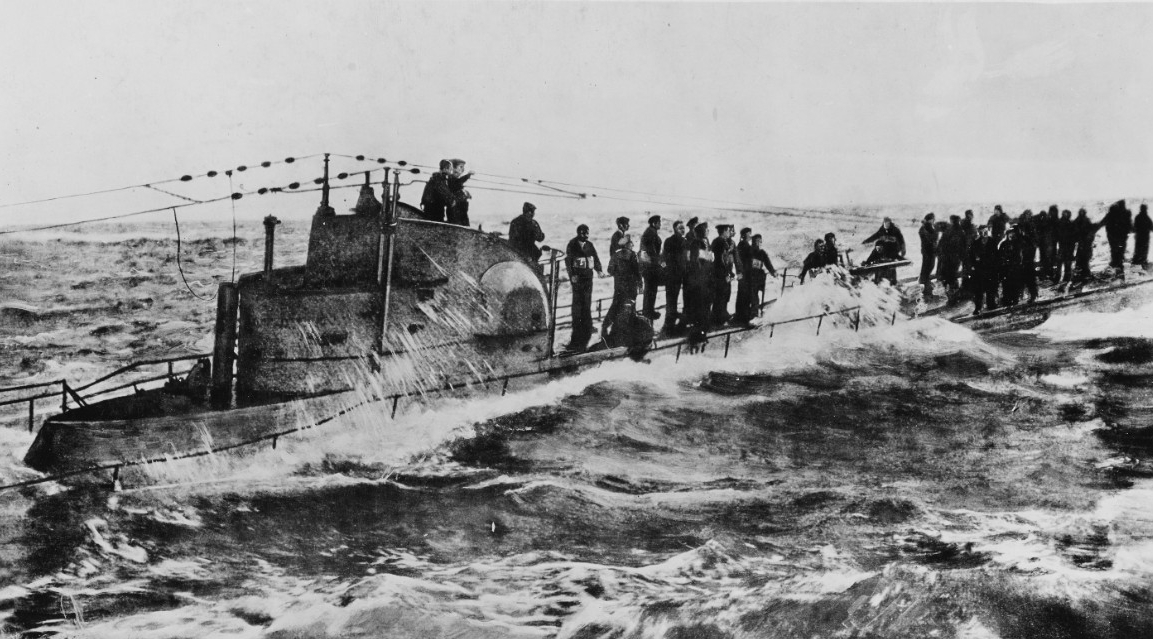
As Fanning helped bring the German sailors on board as POWs, U-58 quickly began to sink. Lines were thrown to the Germans so that they would not drown, and although all the submariners wore life preservers, at least ten or so were too exhausted to grab hold of the lines. A few of the Germans even became tangled up with the radio aerial and were quickly dragged underwater. After noticing one of the German sailors was too exhausted to hold one of the lines, Chief Pharmacist’s Mate Elzer Harwell and Coxswain Francis G. Connor leapt overboard to save the man from drowning. Brought on board, the men tried frantically to revive him, but were unable to do so. The German sailor was buried at sea. Two of Fanning’s crew, Coxswain Loomis and Lt. Walter O. Henry, acting Officer of the Deck (OOD), each received the Navy Cross for their action on 17 November. The British Admiralty also commended both crews of Fanning and Nicholson, as well as their respective commanding officers, Lt. Arthur S. Carpender and Cmdr. Berrien. Both were awarded Distinguished Service Medals for the engagement.
Convoy OQ-20 dispersed as planned at noon on 19 November 1917, and Nicholson continued to maneuver to rendezvous with Convoy HD-11. Having joined the convoy, the destroyer and her fellow escorts shepherded the convoy as ordered and upon the accomplishment of that mission, Nicholson returned to Queenstown on 25 November. Four days later, on 29 November, she, in company with Cummings, Conyngham (Destroyer No. 58), Jacob Jones, Benham, and HMS Camellia, escorted six merchant vessels out of Queenstown and dispersed them two days later at 4:30 p.m. From that point the escort proceeded to a rendezvous to meet the incoming Convoy HS-18. Though there was a reported submarine sighting by the merchantman Dochera on 4 December, an investigation by Nicholson produced negative contact and the escorts convoyed the ships into the British destroyers stationed at Devonport, with no further incident. On 10 December, Nicholson served as flagship for the convoy escort for a convoy consisting of Birmingham (Scout Cruiser No. 2) and 15 ships bound from Liverpool, England, for the Mediterranean. The destroyer and the other escorts convoyed the ships to the separation point without incident. Several days later, Nicholson, again as flagship, this time for Convoy OE-6, reported that on 15 December, she narrowly avoided a collision with a British destroyer that was escorting another convoy as the two passed each other while underway. Nicholson, along with Benham, Jenkins (Destroyer No. 42), Parker (Destroyer No. 48), Cushing, Rowan, Patterson (Destroyer No. 37), and Burrows (Destroyer No. 29), received orders to escort Troop Convoy No. 14 consisting of North Carolina (Armored Cruiser No. 12) and six transports. The rendezvous was conducted on 25 December, and the convoy was brought into port without incident. She ended the year escorting the oiler Minhla from Queenstown to Berehaven, Ireland, in company with Patterson. Afterward, both destroyers escorted the oiler Ottawa from Berehaven to Queenstown.
Getting underway again in the New Year, Nicholson, along with Davis (Destroyer No. 65), Manley (Destroyer No. 74), Flusser (Destroyer No. 20), Monaghan (Destroyer No. 32) and Roe stood out with the transports Finland (Id. No. 4543) and George Washington (Id. No. 3018) on
5 January 1918. Later in the month, on 20 January, Nicholson, serving as flagship, cleared Queenstown, with Allen (Destroyer No. 66), Rowan, Porter, Shaw (Destroyer No. 68), and Conyngham, to escort the troop transports Agamemnon (Id. No. 3004) and Mount Vernon (Id. No. 4508), into Brest (Base No. 7), and Madawaska (Id. No. 3011), into St. Nazaire. The transports and escorts rendezvoused on 22 January, and each ship was escorted into her respective port of debarkation by their escorts without incident on 23 January. Nicholson departed Queenstown to escort Agamemnon and Mount Vernon westward from Brest, in company with Sampson (Destroyer No. 63), Rowan, Porter, Shaw, Wainwright, Wadsworth (Destroyer No. 60), and Conyngham on 30 January. Arriving at Brest, the next day, they cleared the French port later that afternoon. While underway on 1 February, Nicholson, was transferred to U.S. Naval Forces in France based at Brest. Having conveyed the outbound convoy to the dispersal point, Nicholson made contact with the inbound North Carolina and Troop Convoy 18 on 4 February. Having completed her escort mission, on 5 February, she stood into Brest harbor along with Jarvis (Destroyer No. 38) and Wadsworth, and reported for duty to Rear Adm. Henry B. Wilson, Commander, U.S. Naval Forces in France.
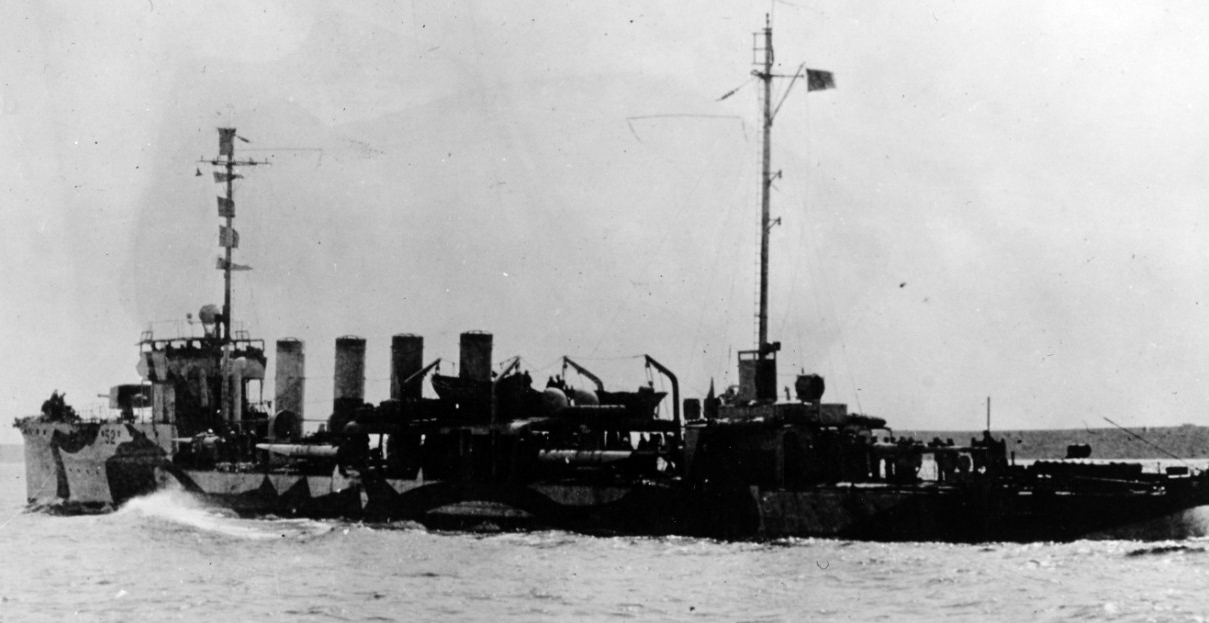
Nicholson, as Senior Officer Present (S.O.P.), stood out of Base No. 7, escorting Convoy HN-43 bound for New York on 10 February 1918, with Whipple (Destroyer No. 15) and four French vessels. While underway the next day, U-53 (Kapitänleutnant Hans Rose) torpedoed the steamer Merton Hall from within the column. The British ship sank quickly as she was loaded with steel, resulting in the loss of almost the entire crew. Reacting to the attack, both destroyers zigzagged to locate the U-boat, but the latter escaped undetected. After the sinking, Nicholson stood back into Brest the next day. Nicholson, Smith (Destroyer No. 17), Warrington (Destroyer No. 30), Reid (Destroyer No. 21), Lamson (Destroyer No. 18), Preston, and Flusser convoyed Powhatan (Id. No. 3013), Ohioan (Id. No. 3280), Aeolus (Id. No. 3005) and Calamares (Id. No. 3662) westward toward the United States on 19 February; the trip was smooth and the speed was 13.5 knots. The next day Nicholson was dispatched to Chatham, England, via the Royal Navy Dockyards at Portsmouth, England, to undergo routine maintenance. She arrived at the yard at Chatham, the next day at 7:00 p.m. With her work completed, she stood in to and moored at Brest on 8 March.
Nicholson left Brest at 7:45 a.m., on 10 March 1918, in company with Wadsworth, Preston, and Flusser, and proceeded to Quiberon Bay, France. Arriving at 2:30 p.m., the destroyers got underway again at 4:00 p.m. escorting DeKalb, Susquehanna (Id. No. 3016), Pastores, and the store ship Mexican (Id. No. 1655). The escorts convoyed the ships to the dispersal point. Separating at 7:30 p.m., on 11 March, the escorts returned to Brest, arriving at 2:00 p.m., on the 12th. Nicholson and Wadsworth cleared Brest at 5:00 p.m., on 17 March, accompanying America (Id. No. 2726) westward. The destroyers parted company with America on the 19th, and while they had some initial difficulty doing so, they rendezvoused with Great Northern (Id. No. 4569) and escorted her in to Brest on 20 March. Three days later, on 23 March, the same three ships stood out of Brest with the outbound America. Having convoyed the ship to the dispersal point, the destroyers separated and returned to Brest. At daylight on 5 April, Wadsworth (flagship), Macdonough (Destroyer No. 9), Reid, Drayton (Destroyer No. 23), Nicholson, Jarvis (Destroyer No. 38) and Preston left in column to meet the inbound transports Northern Pacific, Von Steuben (Id. No. 3017), and Mount. Vernon, 350 miles at sea, all full of U.S. troops. After meeting in the Western Approaches, the escorts convoyed the transports into the French coast.
Nicholson and Jarvis stood out from Brest, on 8 April 1918. Later, on the 14th, Nicholson and Smith joined a convoy consisting of Northern Pacific, Agamemnon and America, in column, led by Wadsworth as flag. The next day, Nicholson and Wadsworth stood in to Brest. Four days later, on 19 April, she was underway again in company with Wadsworth and Drayton. Throughout the end of April and into May, Nicholson, in cooperation with the other destroyers constituting the U.S. Naval Forces in France, escorted transports and store ships into and out of French ports. On 27 May, Nicholson, along with Wadsworth, Jarvis, Drayton, and Roe, escorted the westbound convoy consisting of Covington (Id. No. 1409), Princess Matoika (Id. No. 2290), and Pastores out of Brest to the dispersal point without incident. Leaving the convoy at 8:00 p.m., on 28 May, and returned to Brest on 30 May. Underway again on 1 June, Nicholson and Wadsworth were escorting the transport Leviathan (Id. No. 1326) westward, when the latter sighted a submarine about 1,000 yards off her starboard quarters. She opened fire and Nicholson maneuvered and dropped depth charges over the location of a suspected periscope; damage results, however, unknown. With negative contact the ships continued on until the evening of 2 June, when the escorts parted company and returned to Brest in the afternoon of the 3rd. Two days later, Nicholson was underway again with Wadsworth, this time escorting Great Northern and Northern Pacific from Brest. After convoying the ships until 8:30 a.m., on 6 June, the destroyers returned to Brest the next morning and moored. Nicholson Wadsworth, Fanning, and Wainwright (Destroyer No. 62) departed escorting a convoy consisting of the merchantmen Costerdijk, Dwinsk, Kursk, and Hwah-Jah on 9 June. After escorting them to the dispersal point, the escorts separated at 2:00 a.m., on 11 June, stood back in to Brest later that evening.
Nicholson, destroyer Isabel (S. P. 521), Fanning, Lamson, Flusser, Wainwright, and the French ship Vaillante stood out on 15 June 1918, to rendezvous with Convoy HN-71 which consisted of 20 eastbound ships. Meeting at 5:15 a.m., on the 16th, the escorts accompanied the ships in to port. During the morning of the 17th, the commanding officer of HMS Lance, Senior Escort of Convoy HG-82, requested that Nicholson take the Brest-bound St. Michael under her protection. Though Vaillante collided with Ohioan during the transit, all ships arrived at their respective destinations. Nicholson, Wainwright, Fanning, Isabel, Lamson, and Flusser all stood in to Brest on 17 June. Nicholson, in company with Lamson, Fanning, and Porter, departed with the westbound transport Martha Washington (Id. No. 3019) on 19 June. Parting with the latter at 10:00 p.m., on the 20th, the destroyers made contact with Special Group No. 43 with Leviathan on the 21st. Convoying the ship eastward, the escorts stood into port on 22 June. Three days later, on 25 June, Nicholson and Lamson sortied from Brest and headed to Verdon, France, to meet with the converted yachts Aphrodite (S. P. 135), Nokomis (S. P. 609), and Noma (S. P. 131) and the French gunboats Evielle and Emporte to escort an outbound convoy of 35 ships. Arriving at 9:30 a.m. on 26 June, the convoy formed up and departed later in the evening. Having conveyed the ships to a distance well beyond their initial instructions, the escorts parted company at midnight on the 28th, and returned to Brest the next afternoon. While underway on 1 July, Nicholson responded to the torpedoing of Covington (Id. No. 1409). A week later, on 8 July, Nicholson sortied with Reid, Warrington, Sigourney (flag), Benham, Tucker, Jarvis, and Cummings, convoying Pocahontas (flag), Gold Shell, Susquehanna, Czaritza, Re D’Italia and Duc D'Aosta. Afterward, Nicholson returned to Brest.
Nicholson (flag), in company with Flusser, Smith, Reid, and Lamson, was underway convoying George Washington and HMS Czar and HMS Roepat, Vauban, Ohioan and Mercury. The next day the weather grew worse. At 6:00 a.m., Lamson joined the convoy which was steaming at 9 knots. Five minutes later, Nicholson hoisted the submarine warning flag and opened fire with the 4-inch guns on her starboard bow. Reid went to general quarters and put on 21 knots; gave right rudder and dropped depth charges at 1-second intervals. At 6:10 a.m., Reid observed a torpedo approaching the spot on which Nicholson's gunfire was centered. Reid gave a hard right rudder to avoid the object and circled the spot, dropping 18 depth charges. The last charge set off a sympathetic explosion that was thought to have come from a spent torpedo. At 9:15 p.m., Nicholson, Reid, Lamson, and Flusser left the convoy to meet an incoming convoy bound from New York. Nicholson, Benham, Lamson and Flusser stood in with the convoy on the 21st. Underway again on the 23rd, Nicholson sortied with Burrows and Preston escorting Yale (Id. No. 1672), Charles (Id. No. 1298), and Narragansett (S. P. 2196). Having convoyed the ships to the channel entrance for Portsmouth, the destroyers handed them off to the British patrol vessels in the channel and returned immediately to Brest, arriving at 9:00 p.m. on the 24th.
Nicholson continued to serve as a convoy escort based from Brest through the first weeks in August 1918. Having departed with Warrington, Ericsson, and McDougal, escorting Convoy HR-74 on 20 August, Nicholson sighted a submarine running awash about 1,200 yards distant. Immediately going to full speed, she maneuvered for an attack. She was, however, unable to fire her battery as Warrington was directly in line with the target. The U-boat quickly submerged and Nicholson sped to the spot and dropped depth charges, laying a pattern of 12. While there was some wooden debris that came to the surface and the strong smell of oil, there was no other positive proof of a sunken submarine. The destroyer continued to patrol through the night, searching an area approximately 15 miles square. With daylight, she gave up the search and sped to rejoin the convoy, which she did at 8:00 p.m. She later returned to Brest at the completion of her escort mission. Though subsequent reports of the action believed that the submarine was probably “seriously damaged”, Nicholson was not credited with a second U-boat sinking. She did clear Brest again on 29 August. In company with Drayton, Lamson, Warrington, O'Brien, and Parker, Nicholson escorted Konigen der Nederlanden (Id. No. 2708), Martha Washington, and Henderson (Troop Transport No. 1) westward.
At 7:35 a.m. on 5 September 1918, approximately 250 nautical miles west of Brest, U-82 (Kapitänleutnant Heinrich Middendorff) torpedoed Mount Vernon which was transiting in company with Agamemnon. The resulting explosion knocked out half of her boilers. Nicholson, Conner, Winslow (Destroyer No. 53), and Wainwright (Destroyer No. 62) all depth-charged the U-boat without success, but these defensive efforts prevented the U-boat from administering a coup de grace to the already wounded Mount Vernon. Despite the loss of the boilers and 37 of her 1,450 passengers, Mount Vernon made it safely back to Brest, primarily due to the efforts of Nicholson and the other three escorts to protect her and shepherd her back into port. The destroyer received orders on 11 September authorizing the shortening of her masts and the installation of winches to enable her to employ kite balloons. On 1 October Nicholson stood out with Warrington and Ericsson to serve as one section in a two-section escort for an outbound convoy, after separation with these ships, the destroyers joined an inbound convoy and brought them into the French coast without incident. Later, on 15 October, the destroyer stood out of Brest and then on 19 October, while escorting Group No. 72, she dropped a series of eight depth charges over an oil slick with no apparent result. Nicholson continued her convoy escort mission through the end of the month and into the first week of November. She departed on 7 November escorting Pocahontas into the Irish Sea, at 12:01 p.m., the next day, Nicholson separated and steamed into Queenstown, reporting to the Senior Naval Officer upon her arrival. She then shifted to Liverpool, England on 10 November arriving at 10:00 a.m. She then entered the Cammell Laird Shipyard. The Armistice of the next day found her undergoing routine maintenance.
With hostilities at an end, Nicholson, cleared the yard at 3:00 p.m. on 8 December 1918 and steamed for Base No. 7, arriving at 7:30 a.m. the next day. In company with Jarvis, Monaghan, and Winslow, Nicholson steamed out of Brest on 28 December, and set a course westward for a return to the United States. Touching at the Azores (Base No. 13) on 31 December, the destroyer arrived at Bermuda on 7 January 1919. Continuing on the next day, she raised New York on 10 January, and entered the Navy Yard, that same day for post-deployment overhaul and maintenance. She remained there into spring.
Nicholson, with her yard work completed, cleared New York on 19 May 1919, and steamed to Newport, where she arrived the next day. Remaining until 2 June, she then got underway bound for the U.S. Naval Academy at Annapolis, Md., arriving on the 4th. After embarking a contingent of midshipmen, she departed on the 7th, and returned to Newport on the 10th. From 19 June through 18 August, she operated between Newport and New York, conducting fleet training as part of the Second Division, Destroyer Force. Steaming from Newport on 18 September, the destroyer conducted a series of recruiting port visits on the Long Island Sound and up the Hudson River with calls at Stamford, Conn. (18-25 August); Yonkers, N.Y. (25 August); North River, N.Y. (25 August-10 September); Ossining, N.Y. (10-12 September); Haverstraw, N.Y. (14-18 September); Kingston, N.Y. (30 September-2 October), Poughkeepsie (2-3 October); Catskill, N.Y. (9-10 October); and Albany, N.Y. (10-23 October), before returning to New York and the North River anchorage on the 23rd. Steaming out through the Verrazano Narrows early on 25 October, Nicholson stood into Hampton Roads, later that same day and then entered the Norfolk Navy Yard on the 27th. She would operate from Norfolk through the next few weeks until steaming into New York on 16 November. The next day, she set a course up the Hudson for a return to Albany. Arriving on 18 November, she remained until the 26th. During this time, she received orders on 24 November to report to the Philadelphia Navy Yard to be placed in ordinary. Steaming back down the Hudson, she entered the Atlantic. Passing the Delaware Breakwater, she steamed upriver and arrived at the Philadelphia Navy Yard later on the 26th. The next day, 27 November, Nicholson was placed in reserve commission. In the days following, Lt. James H. Conyne, her commanding officer when she was placed into reserve, stated that repairs would be needed before the ship could be ready for any protracted war service.
On 17 July 1920 Nicholson was re-designated DD-52 as part of a Navy-wide administrative re-organization. Reactivated with a reduced complement on 12 May 1921, she conducted a cruise along the Atlantic coast.
Decommissioned at the Philadelphia Navy Yard on 26 May 1922, Nicholson was stricken from the Navy list on 7 January 1936, and was sold for scrap on 30 June 1936.
| Commanding Officers | Dates of Command |
| Lt. Cmdr. Adolphus E. Watson | 30 April 1915 – 29 June 1916 |
| Lt. Cmdr. Byron A. Long | 29 June 1916– 24 August 1917 |
| Lt. Cmdr. Frank D. Berrien | 24 August 1917 – 29 January 1918 |
| Cmdr. John C. Fremont | 29 January 1918 – 23 March 1918 |
| Cmdr. Charles E. Smith | 23 March 1918 – 12 August 1918 |
| Lt. Cmdr. Thalbert N. Alford | 12 August 1918 – 21March 1919 |
| Lt. James H. Conyne | 21 March 1919 – 31 March 1919 |
| Cmdr. Reed M. Fawell | 31 March 1919 – 10 August 1919 |
| Lt. James H. Conyne | 10 August 1919 – 27 November 1919 |
| Lt. Cmdr. John F. O’Connor | 12 May 1921 – 31 May 1921 |
| Lt. (j.g.) William J. O’Hara | 31 May 1921 – 2 June 1921 |
| Lt. Harold K. Smoot | 2 June 1921 – 19 August 1921 |
| Cmdr. John F. Green | 19 August 1921 – 26 May 1922 |
Christopher B. Havern Sr. and Guy Nasuti
13 November 2017


